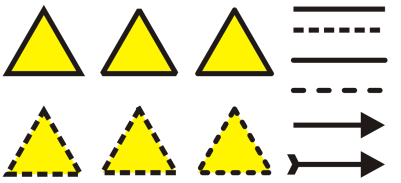Quick links to procedures on this page:
Lines are treated the same way as outlines of closed shapes, such as ellipses and polygons. In some programs, outlines are known as strokes or thick lines.
You can change the appearance of both lines and outlines by using the controls in the Outline section of the Object properties docker, the Outline pen dialog box, and the property bar. For example, you can specify the color, width, and style of lines and outlines.
You can choose a corner style to control the corner shape in lines and choose a line cap style to change the appearance of a line’s endpoints. By default, an outline is applied on top of an object’s fill, but you can apply it behind the fill, with the fill overlapping the outline. You can also link the outline thickness to an object’s size so that the outline increases when you increase the object’s size and decreases when you decrease the object’s size. In addition, you can set the outline to print on top of underlying colors, without removing them during printing.
Different corner styles were applied to the upper and lower row of triangles. Different line caps were applied to the lines in the upper-right corner. Arrowheads were applied to the lines in the lower-right corner.
You can set the miter limit to determine the corner shape in objects containing lines that meet at sharp angles. Corners with angles above the miter limit are pointed (mitered); corners with angles below the miter limit are beveled (squared off).
In addition, you can specify the position of the outline by placing it outside or inside the object, or centering it so that it overlaps equally the outside and the inside of an object. The effect of outline position options are more obvious with thick outlines.
You can specify the position of the outline. Outline options from left to right: Outside, Centered, Inside.
The default line and outline properties for each new object that you draw are as follows:
However, you can change any of these default line and outline properties at any time.
You can create calligraphic outlines. A calligraphic outline varies in thickness, creating the effect of a hand-made drawing.
Creating cuttable outlines
To create a cuttable outline for devices such as plotters, vinyl cutters and Print-Cut devices, you need to assign the appropriate predefined color name (usually CutContour) that is specified by the device manufacturer.
Note that cuttable outlines do not print when identified by the RIP or Print-Cut device. If you want to make the outlines printable, you can use the Object  Shaping
Shaping  Boundary command. For more information, see To create a boundary around selected objects.
Boundary command. For more information, see To create a boundary around selected objects.
| 2 . |
Click Window  Dockers Dockers  Object properties. Object properties. |
| 3 . |
In the Outline section, type a value in the Width box. |
|
If the Outline section is not displayed, click Outline. |
|
|
|
|
|
|
|
|
|
|
|
|
|
|
|
|
|
|
|
|
Enable the Behind fill check box.
|
|
|
Enable the Scale with object check box.
|
|
|
Enable the Overprint outline check box.
|
|
|
Click the Settings button  , and move the slider in the Edit line style dialog box. By clicking the boxes to the left of the slider, you can specify the placement and frequency of the dots in the new line style you create. Click Add.
|
|
|
Choose a line style from the Style list box, and click the Settings button  . Create a line style in the Edit line style dialog box, and click Replace.
|

You can also specify line and outline settings in the Outline pen dialog box. To access the Outline pen dialog box, double-click the Outline icon  on the status bar.
on the status bar.
You can also change the outline width of a selected object by typing a value in the Outline width box on the property bar.
| 2 . |
Click Window  Dockers Dockers  Object properties. Object properties. |
| 3 . |
In the Outline section, click one of the following buttons to set the shape of corners: |
|
If the Outline section is not displayed, click Outline. |
|
If the Stretch box is not displayed, click the arrow button at the bottom of the Outline section. |
| 5 . |
Type a value in the Tilt nib box to change the orientation of the pen in relation to the drawing surface. |
|
To reset the Stretch and Tilt nib values to their original values, click the Default button. |

You can also create a calligraphic outline in the Outline pen dialog box. To access the Outline pen dialog box, double-click the Outline icon  on the status bar.
on the status bar.
You can also adjust the Stretch and Angle values by dragging in the Nib shape preview box.
| 1 . |
Using the Pick tool, click on an empty space in the drawing window to deselect all objects. |
| 3 . |
In the Change document defaults dialog box, enable the check boxes for the objects and text whose default settings you want to change, and click OK. |

Not all suite components documented in this Help are available in our Trial, Academic, and OEM versions. Unavailable components may include Corel applications, product features, third-party utilities, and extra content files.
Copyright 2017 Corel Corporation. All rights reserved.

![]() Shaping
Shaping ![]() Boundary command. For more information, see To create a boundary around selected objects.
Boundary command. For more information, see To create a boundary around selected objects. on the status bar.
on the status bar.
![]()